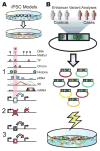Decoding transcriptional enhancers: Evolving from annotation to functional interpretation
- PMID: 27224938
- PMCID: PMC5018832
- DOI: 10.1016/j.semcdb.2016.05.014
Decoding transcriptional enhancers: Evolving from annotation to functional interpretation
Abstract
Deciphering the intricate molecular processes that orchestrate the spatial and temporal regulation of genes has become an increasingly major focus of biological research. The differential expression of genes by diverse cell types with a common genome is a hallmark of complex cellular functions, as well as the basis for multicellular life. Importantly, a more coherent understanding of gene regulation is critical for defining developmental processes, evolutionary principles and disease etiologies. Here we present our current understanding of gene regulation by focusing on the role of enhancer elements in these complex processes. Although functional genomic methods have provided considerable advances to our understanding of gene regulation, these assays, which are usually performed on a genome-wide scale, typically provide correlative observations that lack functional interpretation. Recent innovations in genome editing technologies have placed gene regulatory studies at an exciting crossroads, as systematic, functional evaluation of enhancers and other transcriptional regulatory elements can now be performed in a coordinated, high-throughput manner across the entire genome. This review provides insights on transcriptional enhancer function, their role in development and disease, and catalogues experimental tools commonly used to study these elements. Additionally, we discuss the crucial role of novel techniques in deciphering the complex gene regulatory landscape and how these studies will shape future research.
Keywords: CRISPR genome editing; Development; Disease; Enhancers; Functional genomics; Next-generation sequencing; Transcription factors.
Copyright © 2016 Elsevier Ltd. All rights reserved.
Figures


Similar articles
-
Enhanced Identification of Transcriptional Enhancers Provides Mechanistic Insights into Diseases.Trends Genet. 2016 Feb;32(2):76-88. doi: 10.1016/j.tig.2015.11.004. Epub 2016 Jan 15. Trends Genet. 2016. PMID: 26780995 Review.
-
Functional genomic approaches to elucidate the role of enhancers during development.Wiley Interdiscip Rev Syst Biol Med. 2020 Mar;12(2):e1467. doi: 10.1002/wsbm.1467. Epub 2019 Dec 5. Wiley Interdiscip Rev Syst Biol Med. 2020. PMID: 31808313 Free PMC article. Review.
-
Active enhancers: recent research advances and insights into disease.Biol Direct. 2024 Nov 12;19(1):112. doi: 10.1186/s13062-024-00559-x. Biol Direct. 2024. PMID: 39533395 Free PMC article. Review.
-
High throughput technologies for the functional discovery of mammalian enhancers: new approaches for understanding transcriptional regulatory network dynamics.Genomics. 2015 Sep;106(3):151-158. doi: 10.1016/j.ygeno.2015.06.004. Epub 2015 Jun 10. Genomics. 2015. PMID: 26072436
-
Deciphering the transcriptional cis-regulatory code.Trends Genet. 2013 Jan;29(1):11-22. doi: 10.1016/j.tig.2012.09.007. Epub 2012 Oct 23. Trends Genet. 2013. PMID: 23102583 Review.
Cited by
-
Epigenetic and Transcriptional Networks Underlying Atrial Fibrillation.Circ Res. 2020 Jun 19;127(1):34-50. doi: 10.1161/CIRCRESAHA.120.316574. Epub 2020 Jun 18. Circ Res. 2020. PMID: 32717170 Free PMC article. Review.
-
Transcriptional changes and the role of ONECUT1 in hPSC pancreatic differentiation.Commun Biol. 2021 Nov 17;4(1):1298. doi: 10.1038/s42003-021-02818-3. Commun Biol. 2021. PMID: 34789845 Free PMC article.
-
The Post-GWAS Era: From Association to Function.Am J Hum Genet. 2018 May 3;102(5):717-730. doi: 10.1016/j.ajhg.2018.04.002. Am J Hum Genet. 2018. PMID: 29727686 Free PMC article. Review.
-
Encoding Method of Single-cell Spatial Transcriptomics Sequencing.Int J Biol Sci. 2020 Jul 30;16(14):2663-2674. doi: 10.7150/ijbs.43887. eCollection 2020. Int J Biol Sci. 2020. PMID: 32792863 Free PMC article. Review.
-
Deciphering regulatory DNA sequences and noncoding genetic variants using neural network models of massively parallel reporter assays.PLoS One. 2019 Jun 17;14(6):e0218073. doi: 10.1371/journal.pone.0218073. eCollection 2019. PLoS One. 2019. PMID: 31206543 Free PMC article.
References
-
- Pek JW, Okamura K. Regulatory RNAs discovered in unexpected places. Wiley Interdiscip Rev RNA. 2015;6:671–86. - PubMed
Publication types
MeSH terms
Grants and funding
LinkOut - more resources
Full Text Sources
Other Literature Sources

